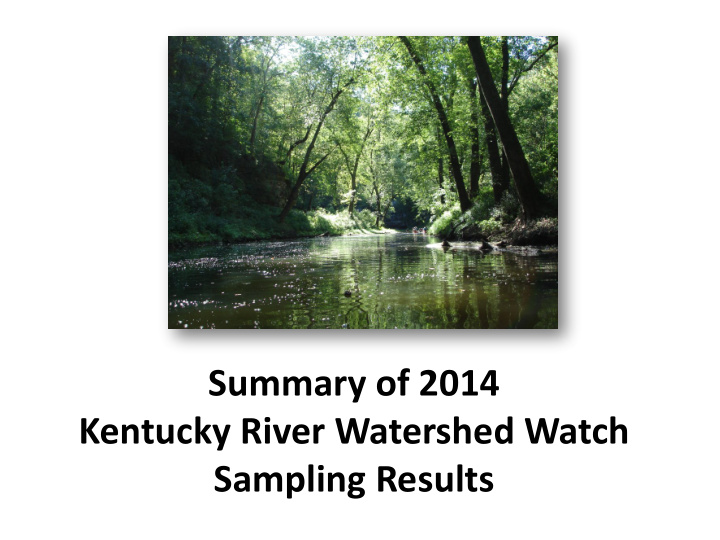



Summary of 2014 Kentucky River Watershed Watch Sampling Results
What and when? Herbicide 16 sites in May Pathogens 115 sites in July 46 re-sampled sites in August Chemicals and Nutrients 85 sites in September Metals 50 sites in September
Total # of KRWW Sites Sampled by Year 300 248 250 231 207 202 197 189 200 # of Sites 176 155 166 166 157 145 134 144 150 115 100 87 50 0 1999 2000 2001 2002 2003 2004 2005 2006 2007 2008 2009 2010 2011 2012 2013 2014
Where?
2013 Sampling Sites
Field Chemistry Dissolved Oxygen – Aquatic Life Standard = 5 mg/L – 43 of 243 readings (18%) < 5 mg/L pH – Aquatic Life Standard = 6 to 9 – Three readings < 6 and two readings > 9 Temperature – One reading > than Aquatic Life Std. of 31.7 ° C Conductivity – Unofficial Aquatic Life Std. of 500 microsiemens/cm – 161 of 263 readings (61%) > 500 µ S/cm
Herbicide: Triazines Widely-used agricultural pesticide to control broadleaf weeds. Can be applied before and after planting crops. Commonly used on corn, sugarcane, sorghum crops. Highly persistent in soil. Associated with concerns about human reproductive effects through drinking water.
Triazine Water Quality Standards EPA Standards only (no Kentucky stds.): Drinking Water Std. = 3.0 micrograms/L Chronic Aquatic Life Std. = 12 micrograms/L Acute Aquatic Life Std. = 350 micrograms/L Triazine detections at 5 of 16 sites. No detections > Standards
Herbicide Results Elkhorn Creek Kentucky River Red Lick Creek Station Camp Creek
Pathogens: E. coli Can indicate presence of pathogens that may cause illness or infections in people. Sources: Failing septic systems Straight pipes Leaking sewage lines Livestock Wildlife, pets
E. coli Water Quality Standards Swimming Standard = 240 cfu/100 ml (instantaneous) Standards apply during Recreation Season from May 1 to October 31.
Synoptic Pathogens (Sampling Dates:7/11/14-7/15/14) 45% of sites out of compliance with safe swimming standards
Follow Up Pathogens (Sampling Dates 8/7/14-8/9/14) 93% of sites out of compliance with safe swimming standards
Best Management Practices for Pathogens Maintain septic systems. Increase municipal sewer line coverage, and repair sewer line leaks. Fence livestock from waterways. Maintain riparian (streamside) vegetation buffers.
Fall Sampling Event NUTRIENT ANALYSIS CRITERIA: ($95/sample –Conductivity, Total Nitrogen, Total Phosphorus, Chloride, Sulfate, Nitrate, Alkalinity and Total Suspended Solids) Offered for all sites METALS ANALYIS CRITERIA: ($70/sample –30 metals) Offered for: • New sampling sites • Eastern Kentucky sites • A few other historically high-metals sites
Nutrients Nitrogen (Total Nitrogen, Nitrate-Nitrogen) Phosphorus (Total Phosphorus) What’s the problem?? High nutrients lead to algal blooms Algae die off Oxygen consumed as algae decomposes DECREASED DISSOLVED OXYGEN LEVELS are bad for aquatic life. Also, can cause taste and odor problems in drinking water or can cause “Blue baby” disease, when oxygen is not transferred effectively throughout the body.
Total Nitrogen and Nitrate-Nitrogen Total Nitrogen Aquatic Life Benchmark = 3 mg/L 29 of 110 2014 TN results > 3 mg/L Nitrate-Nitrogen Drinking Water Supply Std. = 10 mg/L 0 of 110 Nitrate Results > 10 mg/L
Total Nitrogen (Sampling Dates: 9/11/14 – 9/18/14) 26% of sites above recommended limit for aquatic life
Total Phosphorus Used in plant photosynthesis Central Kentucky higher than average natural levels of phosphorus in limestone bedrock & soils Aquatic Life Benchmark for Phosphorus = 0.3 mg/L 34 of 110 Phosphorus Results > 0.3 mg/L
Phosphorus (Sampling Dates: 9/11/14 – 9/18/14) 31% of sites above recommended limit for aquatic life
Conductivity Measure of total dissolved minerals and ions OR the ability of water to carry an electrical current. Levels directly affect aquatic life support, negative impacts observed at 300-500 microSiemens ( µ S)/centimeter. Can serve as indicator of sewage input, mining runoff or other pollutant sources. KRWW Benchmark = 500 µ S /cm
Conductivity Results 61% of field readings > 500 micromhos/cm 65% of lab readings > 500 micromhos/cm
Metals 28 different metals analyzed for 50 sites Only 14 metals w/ associated Water Quality Standards 12 have Drinking Water Supply Standard (DWS) 10 have Warm Water Aquatic Habitat Standard (or AL for Aquatic Life)
Metal Readings > Standards # of Drinking # of Acute # of Chronic Site with Metal Water (short-term) (long-term) Highest Analyte Standard Aquatic Life Aquatic Life Reading Exceedances Exceedances Exceedances Aluminum 0 13 N/A #1209 Beryllium 1 N/A N/A #1209 Copper 0 2 1 #3353 Iron 29 17 9 #1209 Lead 0 1 1 #1209 Nickel 2 2 2 #1209 Thalium 1 N/A N/A #921 Zinc 0 3 3 #1209
Habitat and Biological Results 8 Sites Assessed for Habitat and Biology Habitat: Biology: 4 good 0 good 2 fair 7 fair 2 poor 1 poor
Biological and Habitat Assessments
Summary of Results • Lists all sites with location descriptions & sampler names. • Provides subjective rating of good , fair , and poor for each water quality category. • Sites of concern noted by shading.
2014 Sites of Concern ! South Elkhorn Creek Watershed (Fayette Co.) Wolf Run Watershed Sites #915, #1128, #1132, #1135, #1137, #1138, #1139, #3059 Shannon Run Watershed (Woodford Co.) Site #1048 ! Glenn’s Creek Watershed (Woodford Co.) Sites #823, #954 ! West Hickman Creek Watershed (Fayette Co.) Sites #1020, #1021
2014 Sites of Concern ! Mock’s Branch Watershed (Boyle Co.) Site #3133 ! Kentucky River Palisades (Woodford Co.) Site #954 ! Clear Creek (Woodford Co.) Site #922 ! Lower Howards Creek (Clark Co.) Site #3282 ! Carr Fork (Perry Co.) Site #875
2014 Sites of Concern ! Rockhouse Creek (Letcher Co.) Site #3084 ! North Fork Kentucky River Headwaters (Letcher Co.) Sites #802, 803, 1151, 848, 1209, 1242, 1248
2014 KRWW Sites & Watersheds of Concern
Recommend
More recommend